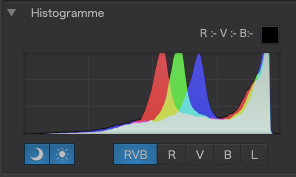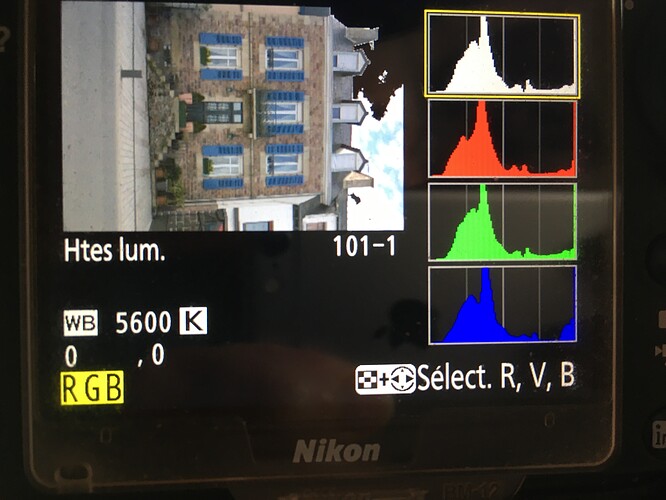Could be me, but is ETTR not the opposit?
Dial exposure up until there is no free space on the rightside of histogram?
Oops, I typed “blinkies” and my computer keeps trying to change that to “blinks”. What I’m trying to say is if the “blinkies” in my viewfinder are flashing, those parts of my image will be burnt out, and that is to be avoided.
Years ago, I used to shoot for the shadows, hoping the highlights would still be good. Now I’ve learned I can correct for the underexposed parts of my image later on, but there is no correction for the over-exposed parts of the image. Joanna has shown me that if the exposure for the whitest parts of my image is maybe one stop over exposed, I will still get a useful image. I used to expose for the highlights, but what I expected to come out “white” was instead a “light gray”.
I’m not saying this as well as what Joanna showed me, but I thinking I’m achieving the results that she was trying to teach me. I think of this as ETTR.
It’s the opposite. As little as possible.
George
What Peter and George have both pointed out is that, with an ETTR histogram, the right end should be fairly full but not completely up against the right edge, which would provoke the blinkies.
These shots demonstrate what an ETTR histogram should look like.
Before editing…

With one or two minute over-exposure warnings (dots)
After editing…

Not forgetting that the histogram you see on the back of the camera is for the jpeg. You’ve actually got a bit more wiggle room in the RAW image, despite the blinkies, which you can recover in post-processing. The trick is to get to know just how much you can get away with.
With this image, PL shows the top left corner as ever so slightly over-exposed…


Compare that with the blinkies and histogram on the back of the camera…
Quite some difference !
… and yet, this is what I managed to get out of it with PL…

Aha!!! You obviously are both right, and I (equally obviously) was wrong. I aimed my camera out the window and trie shooting as I moved the histogram towards the right. Once it got all the way to the right, the blinkies started, and beyond that, they got worse and worse (as more an more parts of my image got over-exposed. So, I started to move the histogram back to the left, and once it was “away from” the right edge, the blinkies were gone.
My brain was screwed up - I thought I knew what you all meant, but this is the first time I deliberately tried it out on my camera.
Therefore, by definition, the more I move the histogram towards the left, the darker the “white” areas will get, as you showed me with my boat photo.
So, unless you tell me otherwise, I guess I want the histogram as far to the right as possible, but not touching the right edge of the box.
Learning by reading is good to a point. Learning by testing is much better for me. Now I have a “feel” for what to do, along with the “instructions”. 
I used to think the histogram should be more or less centered in the “box”. Apparently that was not a good goal - or am I missing other things?
The only time you really need to think about ETTR is either when you want to make something white appear white and not grey, or when you are shooting a high contrast scene, where you are trying to fit in as wide a range of shadow to highlight as possible. Otherwise, in the middle is fine.
The histogram is just a representation of the pixel values. A shot in the snow will show you a histogram focused on the right,white, side. A night shot will be more on the left,dark side.
The idea of ettr is, if you have room on the right side to expose more, use that room and correct it afterwards. By correcting afterwards you also minimize noise.
George
Thanks - understood. Keep histogram more or less in the middle, unless it’s a high contrast scene. If there is lots of “white” (as in snow), move histogram to the right so the snow will appear white after processing.
Agreed. Keep histogram towards the middle. But if it’s a mostly white scene, move the histogram to the right side, so the “white” won’t turn “light gray”, and I won’t need to correct for this so much when processing.
I thought I understood before. I’m still learning.
NO,NO,NO!!!
It is a represtation of the pixel values of your IMAGE. If you exposed well, then the snow will be in the right.
The only practical info a histogram has, is the clipping info and if you could expose longer.
George
OK, if the histogram is centered, with lots of room to the right, expose more, shifting the histogram to the right, as with “more exposure” there will be “less noise”. Got it!
Not yet. ETTR means overexposing, so you’ve to correct that afterwards.
The idea behind this is that noise is a value of a certain amount. Let’s say that noise will add a value of 20 to the normal pixel value. If your normal pixel value would be 10, then it will become 30, 3 times the original value. That’s a lot. If your normal value is 200, then it will become 220, 1,1 time the original.
Correcting the exposure affects the noise too. If your corrections are so that the 10 will become 5, then the noise will become 15. So the addition for the noisse is now 10 and not 20. That’s the idea of ettr.
These are simple calculations.
George
I think I understand - but I thought that an hour ago as well. I’ll go out and try this deliberately. If I want white snow, not gray snow, I need to over-expose the image. OK, if I deliberately over-expose, the histogram moves to the right, not to the left. Makes sense, as there is more “light” than “dark”.
…you’re right. As I over expose more, the histogram moves to the RIGHT, not to the left.
Again no. ![]()
When shooting in snow, you must correct the results of the light meter. The light meter measures the light it catches and does some calculations so that that exposure is somewhere in the middle of the histogram. That’s what you have to correct. And then the snow will be white, on the right side.
Another way to formulate is that the light meter is calibrated at something as 18%. This means it is assuming that the light it catches is coming from a surface that reflects 18% of the light. But snow, white, reflects much more. And that’s what you have to correct.
We’re talking about reflective light
George
OK, is this better - if I am shooting a scene with a lot of white (perhaps snow), the averaging meter in the camera will be trying for the appropriate gray color, but since I want white, not gray, I need to ad more exposure. As I add more exposure, the resulting image will be lighter, and the histogram will reflect this, being more to the right.
Yes, reflective light. If I was using an incident light meter, I’d maybe get a different result.
OK so far?
In the sense you are using it up above, what is “noise” ?
I assume by pixel value, you are referring to how bright the pixel thinks the light is.
Where does this “noise” come from?
I have no idea what you are trying to describe, but I realize I have a lot yet to learn.
Noise is equal on all pixels but on the lower charged one’s it has a larger impact.
So the left part of the histogram, shadows, holds more visible noise.
So by shifting your hole image as far as posible to the bright side when exposing say +1EV, the noise is a smaller % of the exposurevalue’s. Example:150+15noise is 10% and 300+15noise is 5%.
So when you correct this is post , in dxopl, by -1EV the shadows have less noise visible then when you just exposed correctly(done by AE of camera). (you don’t add noise with post EV correction only make it visible when lifting shadows.)
That’s the practical use of Expose to the right.
Put that way, I understand!
Of course, that being the case, why would I change anything else, when I can just set the exposure compensation setting to +1EV ??
Regardless, now I understand what you are saying, and why. Slightly over-expose by +1EV when taking the photo, meaning there will be less of an effect from noise, and then compensating with -1 EV in processing to make things correct.
Yep, true. (i didn’t want it to be to detailed/technical.)
On longer exposures times due low lumination(less light). Then the shotnoise starts to cummulate when you crank up the exposure(time).
And dailing up ISO is lowering DR so the ETTR is countereffective.
I talk about normal daylight situations with lots of light.
Say i have 1/800sec or 1/1000sec of ss and a bright building in the sun and a tree and under that tree is your family. The bright wall of the building is causing deeper shadows under the tree. (AE is targeting average and thus bright wall has a large influence on that.)
Option one. Take AEpoint to family under tree ss drops to 1/400sec or even 1/200sec
Brightwall is near blown lightlights or even over the clipping point. (histogram shows.)
Option two, dail EV compensation up until you are satified or hit the rightside of the histogram. What ever comes first.(ETTR)
In this scenario the family in the shadows are less noisy. So you can lift in post more.
Now you came back for diner in the late afternoon, the sun is down.
Your family is again under the tree and in a darker place then the white wall.
Ss is 1/30sec. Ibis and ios so handheld.
Now adjusting of exposure does bring ss to nearly a minute or you need to raise iso to 3200 6400. Or fully open aperture losing dof.
In this case ETTR is causing extra noise. Then ETTL is the best option.(assuming your family isn’t in the blackisch part of the image but somewhere in the middle part of the histogram.)
Let the image bounce to near black in histogram. Then adjust aperture as much as you can lose dof to fully open(more light/sec is less noise). Balance iso and ss to have a 1/60sec.
(edit, because it’s a evening/afternoon scene we expect some deep dark area’s in a scene and the wall doesn’t be white. We want the middle section where the family is in as propper exposed as posible.
Same options here, aim AE on family hope for dedent outcome or manual EVcompensate watching histogram wile optimising settings.)
This causes less shotnoise and you don’t need the DR of base iso because it’s not that bright. The faster ss has also less motion blur. In post you can controlled raise EV and selective tone wile watching for noise.
(I simplified the noise part in 10% 5 % example. We talked about it and i showed this in his first apartment shots with the plus 2 ev the dark windows had less noise then the auto exposure in the middle of the histogram.)
Every choise is has a cost.![]()




